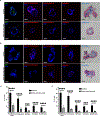Colonic crypt stem cell functions are controlled by tight junction protein claudin-7 through Notch/Hippo signaling
- PMID: 38598500
- PMCID: PMC11111361
- DOI: 10.1111/nyas.15137
Colonic crypt stem cell functions are controlled by tight junction protein claudin-7 through Notch/Hippo signaling
Abstract
The tight junction protein claudin-7 is essential for tight junction function and intestinal homeostasis. Cldn7 deletion in mice leads to an inflammatory bowel disease-like phenotype exhibiting severe intestinal epithelial damage, weight loss, inflammation, mucosal ulcerations, and epithelial hyperplasia. Claudin-7 has also been shown to be involved in cancer metastasis and invasion. Here, we test our hypothesis that claudin-7 plays an important role in regulating colonic intestinal stem cell function. Conditional knockout of Cldn7 in the colon led to impaired epithelial cell differentiation, hyperproliferative epithelium, a decrease in active stem cells, and dramatically altered gene expression profiles. In 3D colonoid culture, claudin-7-deficient crypts were unable to survive and form spheroids, emphasizing the importance of claudin-7 in stem cell survival. Inhibition of the Hippo pathway or activation of Notch signaling partially rescued the defective stem cell behavior. Concurrent Notch activation and Hippo inhibition resulted in restored colonoid survival, growth, and differentiation to the level comparable to those of wild-type derived crypts. In this study, we highlight the essential role of claudin-7 in regulating Notch and Hippo signaling-dependent colonic stem cell functions, including survival, self-renewal, and differentiation. These new findings may shed light on potential avenues to explore for drug development in colorectal cancer.
Keywords: cell differentiation; claudin‐7; colonic epithelial stem cells; colonoid culture; colorectal cancer.
© 2024 The Authors. Annals of the New York Academy of Sciences published by Wiley Periodicals LLC on behalf of The New York Academy of Sciences.
Conflict of interest statement
COMPETING INTERESTS
The authors declare no competing interests.
Figures









Similar articles
-
Tight Junction Protein Claudin-7 Is Essential for Intestinal Epithelial Stem Cell Self-Renewal and Differentiation.Cell Mol Gastroenterol Hepatol. 2020;9(4):641-659. doi: 10.1016/j.jcmgh.2019.12.005. Epub 2019 Dec 23. Cell Mol Gastroenterol Hepatol. 2020. PMID: 31874254 Free PMC article.
-
Three-Dimensional Culture of Murine Colonic Crypts to Study Intestinal Stem Cell Function Ex Vivo.J Vis Exp. 2022 Oct 11;(188):10.3791/64534. doi: 10.3791/64534. J Vis Exp. 2022. PMID: 36314830 Free PMC article.
-
Claudin-7 is essential for the maintenance of colonic stem cell homoeostasis via the modulation of Wnt/Notch signalling.Cell Death Dis. 2024 Apr 23;15(4):284. doi: 10.1038/s41419-024-06658-x. Cell Death Dis. 2024. PMID: 38654000 Free PMC article.
-
Intestinal epithelial claudins: expression and regulation in homeostasis and inflammation.Ann N Y Acad Sci. 2017 Jun;1397(1):66-79. doi: 10.1111/nyas.13360. Epub 2017 May 10. Ann N Y Acad Sci. 2017. PMID: 28493289 Free PMC article. Review.
-
Regulatory Mechanism of Intestinal Stem Cells Based on Hippo Pathway and Signaling Crosstalk in Chicken.Int J Mol Sci. 2025 May 24;26(11):5067. doi: 10.3390/ijms26115067. Int J Mol Sci. 2025. PMID: 40507877 Free PMC article. Review.
Cited by
-
Exploring Importance and Regulation of Autophagy in Cancer Stem Cells and Stem Cell-Based Therapies.Cells. 2024 Jun 1;13(11):958. doi: 10.3390/cells13110958. Cells. 2024. PMID: 38891090 Free PMC article. Review.
-
The emerging role of intestinal stem cells in ulcerative colitis.Front Med (Lausanne). 2025 Mar 25;12:1569328. doi: 10.3389/fmed.2025.1569328. eCollection 2025. Front Med (Lausanne). 2025. PMID: 40201327 Free PMC article. Review.
References
MeSH terms
Substances
Grants and funding
LinkOut - more resources
Full Text Sources
Medical

